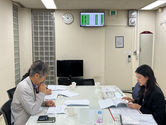Field Study
As part of my field study, I visited the Ministry of Economy and Finance to better understand how the national budget is allocated for elderly welfare. Through interviews with officials, I gained insight into the structure and priorities of current spending. From this research, I identified key issues and gaps in support systems, leading me to develop a policy proposal focused on implementing an “Elderly Fine” system—an initiative aimed at addressing specific challenges faced by aging populations. This proposal was submitted to the Ansan City Council as a step toward more responsive and sustainable elderly care policy at the local level.
Reconciling Tradition and Modernity: Addressing Dementia Care Challenges In South Korea's Aging Society
Interview from Ministry of Economy and Finance

Policy Bureau
Han Pil Choi
.png)
When setting the budget, how much can you reflect social issues or elderly-related problems?

Amy Hwang

It's not always possible to create budgets that are perfectly aligned with specific targets, as the total budget is set in advance and then distributed. While we strive to be proactive by allocating funds to each department, it's a persistent frustration that a budget for a particular issue is often only established or increased after it gains traction in the media.
.png)
How are budgets or policies being planned to address the digital divide among the elderly?


Social Welfare Department
Junsung Kim




In truth, kiosks are incredibly common in Korea, yet at places like bus terminals, grandmothers and grandfathers still go to the counter to buy their tickets. From our perspective, this might seem rather inconvenient. Logically, this would mean that education should be provided to help them use these digital devices, and in fact, many such educational programs are already in place. The senior welfare budget even includes funds for digital literacy. However, it seems that seniors find the very act of using these devices to be a hassle. Another problem is that simply saying, 'We need to solve this issue for the elderly,' and tossing out the agenda item doesn't actually resolve anything. It would be truly wonderful if there were more opportunities for us to collectively deliberate on the finer details: what the problem actually is, how we can solve it, and how the budget should be structured to support that solution.
.png)
What challenges do you face when allocating budgets for elderly-related programs?


Budget Management Department
Kyuwon Choi




In reality, securing a budget requires a significant verification process. This involves comparing various options, and the process becomes much simpler if there is at least one solid success case to serve as a benchmark. However, starting from a blank slate is challenging in a government system like ours that demands proof of performance. This makes it difficult to allocate an appropriate budget, even for a worthy initiative. Furthermore, programs and their budgets must be designed to reflect the unique characteristics of the elderly. This is complicated by the fact that even within the senior population, there are vast differences in income and educational levels among those born in the 1930s, 40s, and 50s. Because of this heterogeneity, securing a budget is an arduous task, even for an excellent proposal.
From the Ministry of Economy and Finance interview, it became clear that
1) The Structural Limitations of Pre-Determined Budgets
2) The Lack of Proven Success Cases
3) The Significant Differences in Income and Learning Levels
make it difficult to allocate proactive funding to address the digital divide among the elderly.
To tackle this challenge, I proposed the “Elderly Fine” initiative, which shifts the focus from mere digital education to behavioral change, creating tangible outcomes that can serve as a compelling case for justified budget allocation to the Ansan City Council.
And My Proposal looked like this.
.
.
.
In my presentation to the Ansan City Council, I introduced the concept of the Elderly Fine, a policy proposal developed through field research and interviews with the Ministry of Economy and Finance.
The proposal addresses:
1) Gaps in elderly welfare funding by suggesting a targeted fine system aimed at reinforcing accountability
2) Generating additional resources for senior care programs.
I outlined the policy rationale, presented data from national budget allocations, and identified specific areas where elderly services fall short.
The presentation concluded with actionable recommendations tailored to Ansan’s local context, encouraging the council to consider sustainable, community-based funding models to better support the city’s aging population.













